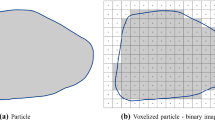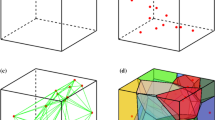Abstract
The angularity of particles has important effects on the mechanical properties of asphalt mixture and other granular materials. To simulate these effects, the glue-sphere method was usually used to create an arbitrary polyhedron particle. Unlike other studies, this paper aims to efficiently fill a polyhedron with as few spheres as possible through optimization technology in order to reduce the cost of calculation during mixture simulation. Four contents are mainly discussed here: a) how to produce non-spherical aggregates and control their sizes with the minimal bounding box; b) how to fill convex non-spherical particles with the fewest balls as possible using the constrained nonlinear optimization method; c) how to compute the typical shape factors of these particles; and d) how the control parameters affect the filling effect. The algorithm for this study was programmed by MATLAB software and was proven to have better filling performance and less computational cost compared to other methods.
Similar content being viewed by others
References
Abreu, C. R., Tavares, F. W., and Castier, M. (2003). “Influence of particle shape on the packing and on the segregation of spherocylinders via Monte Carlo simulations.” Powder Technology, Vol. 134, No. 1, pp. 167–180, DOI: 10.1016/s0032-5910(03)00151-7.
Arasan, S., Yenera, E., Hattatoglu, F., Hinislioglua, S., and Akbuluta, S. (2011). “Correlation between shape of aggregate and mechanical properties of asphalt concrete: Digital image processing approach.” Road Materials and Pavement Design, Vol. 12, No. 2, pp. 239–262, DOI: 10.1080/14680629.2011.9695245.
Bandyopadhyaya, R., Das, A., and Basu, S. (2008). “Numerical simulation of mechanical behaviour of asphalt mix.” Construction and Building Materials, Vol. 22, No. 6, pp. 1051–1058, DOI: 10.1016/j.conbuildmat.2007.03.010.
Barber, C. B., Dobkin, D. P., and Huhdanpaa, H. (1996). “The quickhull algorithm for convex hulls.” ACM Transactions on Mathematical Software (TOMS), Vol. 22, No. 4, pp. 469–483, DOI: 10.1145/235815.235821.
Barequet, G. and Har-Peled, S. (2001). “Efficiently approximating the minimum-volume bounding box of a point set in three dimensions.” Journal of Algorithms, Vol. 38, No. 1, pp. 91–109, DOI: 10.1006/jagm.2000.1127.
Barrett, P. J. (1980). “The shape of rock particles, a critical review.” Sedimentology, Vol. 27, No. 3, pp. 291–303, DOI: 10.1111/j.1365-3091.1980.tb01179.x.
Buttlar, W. G. and You, Z. (2001). “Discrete element modeling of asphalt concrete: Microfabric approach.” Transportation Research Record: Journal of the Transportation Research Board, Vol. 1757, No. 1, pp. 111–118, DOI: 10.3141/1757-13.
Chang, C. S. and Chao, S. J. (1994). “Discrete element analysis for active and passive pressure distribution on retaining wall.” Computers and Geotechnics, Vol. 16, No. 4, pp. 291–310, DOI: 10.1016/0266-352x(94)90012-4.
Chen, J. S., Chang, M. K., and Lin, K. Y. (2005). “Influence of coarse aggregate shape on the strength of asphalt concrete mixtures.” Journal of the Eastern Asia Society for Transportation Studies, Vol. 6, pp. 1062–1075, DOI: 10.11175/easts.6.1062.
Cho, G., Dodds, J., and Santamarina, J. C. (2006). “Particle shape effects on packing density, stiffness, and strength: Natural and crushed sands.” Journal of Geotechnical and Geoenvironmental Engineering, Vol. 132, No. 5, pp. 591–602, DOI: 10.1061/(asce)1090-0241(2006) 132:5(591).
Collop, A. C., McDowell, G. R., and Lee, Y. (2004). “Use of the distinct element method to model the deformation behavior of an idealized asphalt mixture.” International Journal of Pavement Engineering, Vol. 5, No. 1, pp. 1–7, DOI: 10.1080/10298430410001709164.
Cundall, P. A. (1971). “A computer model for simulating progressive, large-scale movements in block rock systems.” Proc. Symp. Int. Soc. Rock Mech, France.
Legland, D. (2009). File: geom3d, http://www.mathworks.cn/matlabcentral/fileexchange/24484-geom3d.
Ferellec, J. F. and McDowell, G. R. (2010). “A method to model realistic particle shape and inertia in DEM.” Granular Matter, Vol. 12, No. 5, pp. 459–467, DOI: 10.1007/s10035-010-0205-8.
Hentschel, M. L. and Page, N. W. (2003). “Selection of descriptors for particle shape characterization.” Particle & Particle Systems Characterization, Vol. 20, No. 1, pp. 25–38, DOI: 10.1002/ppsc.200390002.
Hosseininia, E. S. and Mirghasemi, A. A. (2006). “Numerical simulation of breakage of two-dimensional polygon-shaped particles using discrete element method.” Powder Technology, Vol. 166, No. 2, pp. 100–112, DOI: 10.1016/j.powtec.2006.05.006.
Korsawe, J. (2008). File: Minimal Bounding Box, http://www.mathworks.com/matlabcentral/fileexchange/18264-minimal-bounding-box.
Kalcheff, I. V. and Tunnicliff, D. G. (1986). “Effects of crushed stone aggregate size and shape on properties of asphalt concrete.” In Proc. of AAPT, Vol. 51, pp. 453–483.
Kim, H. and Buttlar, W. G. (2005). “Micromechanical fracture modeling of asphalt mixture using the discrete element method.” GSP 130: Advances in Pavement Engineering, Proc., Sessions of the Geo-Frontiers 2005 Congress, ASCE, Reston, USA, pp. 209–223.
Langston, P. A., Al-Awamleh, M. A., Fraige, F. Y., and Asmar, B. N. (2004). “Distinct element modelling of non-spherical frictionless particle flow.” Chemical Engineering Science, Vol. 59, No. 2, pp. 425–435, DOI: 10.1016/j.ces.2003.10.008.
Lee, C., Suh, H. S., Yoon, B., and Yun, T. S. (2017). “Particle shape effect on thermal conductivity and shear wave velocity in sands.” Acta Geotechnica, Vol. 12, No. 3, pp. 615–625, DOI: 10.1007/s11440-017-0524-6.
Lin, X. and Ng, T. T. (1997) “A three-dimensional discrete element model using arrays of ellipsoids.” Geotechnique, Vol. 47, No. 2, pp. 319–329, DOI: 10.1680/geot.1997.47.2.319.
Liu, Y. and You, Z. (2009). “Visualization and simulation of asphalt concrete with randomly generated three-dimensional models.” Journal of Computing in Civil Engineering, Vol. 23, No. 6, pp. 340–347, DOI: 10.1061/(asce)0887-3801(2009)23:6(340).
Liu, Y., You, Z., and Zhao, Y. (2012). “Three-dimensional discrete element modeling of asphalt concrete: Size effects of elements.” Construction and Building Materials, Vol. 37, pp. 775–782, DOI: 10.1016/j.conbuildmat.2012.08.007.
Mollanouri Shamsi, M. M. and Mirghasemi, A. A. (2012). “Numerical simulation of 3D semi-real-shaped granular particle assembly.” Powder Technology, Vol. 221, pp. 431–446, DOI: 10.1016/j.powtec.2012.01.042.
Ng, T. T. and Wang, C. (2001). “Comparison of a 3-D DEM simulation with MRI data.” International Journal for Numerical and Analytical Methods in Geomechanics, Vol. 25, No. 5, pp. 497–507, DOI: 10.1002/nag.139.
Oduroh, P. K., Mahboub, K. C., and Anderson, R. M. (2000). “Flat and elongated aggregates in superpave regime.” Journal of Materials in Civil Engineering, Vol. 12, No. 2, pp. 124–130, DOI: 10.1061/(asce)0899-1561(2000)12:2(124).
Pourghahramani, P. and Forssberg, E. (2005). “Review of applied particle shape descriptors and produced particle shapes in grinding environments. Part I: Particle shape descriptors.” Mineral Processing & Extractive Metall. Rev., Vol. 26, No. 2, pp. 145–166, DOI: 10.1080/08827500590912095.
Shin, H. and Santamarina, J. C. (2012). “Role of particle angularity on the mechanical behavior of granular mixtures.” Journal of Geotechnical and Geoenvironmental Engineering, Vol. 139, No. 2, pp. 353–355, DOI: 10.1061/(asce)gt.1943-5606.0000768.
Suh, H. S., Kim, K. Y., Lee, J., and Yun, T. S. (2017). “Quantification of bulk form and angularity of particle with correlation of shear strength and packing density in sands.” Engineering Geology, Vol. 220, pp. 256–265, DOI: 10.1016/j.enggeo.2017.02.015.
Taghavi, R. (2011). “Automatic clump generation based on mid-surface.” 2nd International FLAC/DEM Symposium, Melbourne, pp. 791–797.
Ting, J. M., Khwaja, M., Meachum, L. R., and Rowell, J. D. (1993). “An ellipse-based discrete element model for granular materials.” International Journal for Numerical and Analytical Methods in Geomechanics, Vol. 17, No. 9, pp. 603–623, DOI: 10.1002/nag.1610170902.
Wikipedia (2017). On http://en.wikipedia.org/wiki/Discrete_element_method#Software.
Williams, J. R. and O’Connor, R. (1995). “A linear complexity intersection algorithm for discrete element simulation of arbitrary geometries.” Engineering Computations, Vol. 12, No. 2, pp. 185–201, DOI: 10.1108/02644409510799550.
You, Z., Adhikari, S., and Dai, Q. (2008). “Three-dimensional discrete element models for asphalt mixtures.” Journal of Engineering Mechanics, Vol. 134, No. 12, pp. 1053–1063, DOI: 10.1061/(asce) 0733-9399(2008)134:12(1053).
Author information
Authors and Affiliations
Corresponding author
Rights and permissions
About this article
Cite this article
Zhou, C., Yue, H., Li, Y. et al. A Sphere Filling Algorithm for Irregular Aggregate Particle Generation based on Nonlinear Optimization Method. KSCE J Civ Eng 23, 120–129 (2019). https://doi.org/10.1007/s12205-018-0182-8
Received:
Revised:
Accepted:
Published:
Issue Date:
DOI: https://doi.org/10.1007/s12205-018-0182-8




